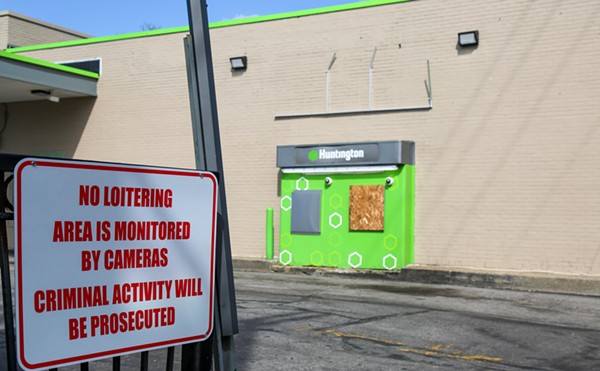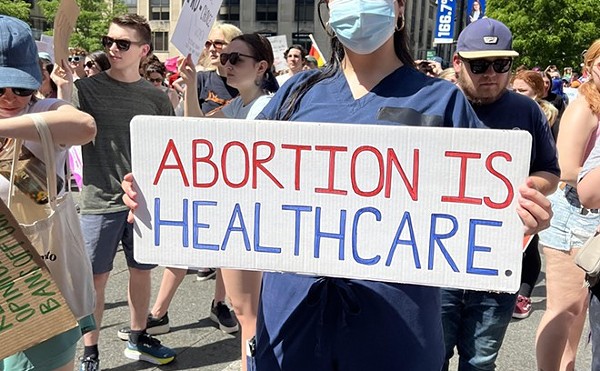The sign on the door of St. Casimir's says PRIVATE PROPERTY, NO TRESPASSING. The chain-link fence that surrounds the Catholic church once protected its brown bricks from graffiti artists who menace the Superior/St. Clair neighborhood. Now it keeps out the faithful, who can no longer get in but refuse to go away.
The Diocese of Cleveland shuttered St. Casimir in November, part of Bishop Richard Lennon's plans to snuff out more than four dozen parishes across the region by July 4. The week after St. Casimir's closed, 79-year-old Michael Klymiuk-Wieczerski had a dream. The Virgin Mary appeared to the retired doctor, imploring him not to let St. Casimir's go quietly.
So he began calling fellow parishioners and inviting them back. Ever since, they've convened outside the building at Sowinski Avenue and East 82nd Street every Sunday — Klymiuk-Wieczerski and dozens of other Catholics, formerly of St. Casimir's and other closed parishes all over Northeast Ohio. Throughout the frigid winter they gathered in prayer, to decry the campaign that silenced their church and the bishop whose bidding it was. They crave the unity they once enjoyed when St. Casimir was the spiritual center of their universe.
Today is a nice day for prayer and protest, 11:30 on a sunny Sunday in late May. The 40 or so who have assembled are the only white faces amid streets with names like Pulaski and Kosciuszko — among the few reminders that this was once a neighborhood known as "Poznan," dense with Polish immigrants. Lifelong parishioners guess that maybe 20 percent of the flock, tops, still lived in the area in Casimir's final days.
With no clergyman in sight, the services are informally led by a trio including Wojciech Fleszar. A native of Krakow, he's been in America for 20 years, attending St. Casimir for the past 12. A church sits across the street from his Chardon home, but he drives 47 miles to be here.
"I welcome you again in front of the closed door of our church," says Fleszar, in the soft-edged accent of his homeland. "We get in here every week for one reason: to stop closing our churches, so we can meet not outside, but inside our beautiful church. It's something amazing ... Pray for Bishop Lennon, that the Holy Spirit will open his heart, and for all Catholics."
Since the bishop's arrival in 2006, many believers say they have yet to see an open heart. Lennon came to town on a wave of negative publicity, plucked from a Boston archdiocese racked by sexual abuse scandals. His reputation there was that of an unfeeling businessman sent to do the church's bidding, a hatchet man in holy cloth. In the eyes of many, his legacy has been solidified here.
In his third year on the job, Lennon announced plans to shutter 50 churches, most of them in or around Cleveland.
"This is not Rome doing this," says St. Casimir parishioner Joe Feckanin. "The church is being attacked from within by these heartless bishops."
Unlike many of the doomed, St. Casimir's appeared financially healthy. A parishioner who has seen the books says the church had over $300,000 in its bank account when it was closed — enough to sustain it for years, even if its members and generous alumni chapter were to suddenly stop donating. The six-building campus — which includes the parish hall and rectory — is on sale for $975,000. Its pastor, Leo Talesz, retired when the church was closed.
"There weren't many people that were left there," says diocesan spokesman Robert Tayek. "At St. Casimir's, in the year 2007, there were two baptisms. The mass [attendance] counts were down ... There really wasn't any activity to speak of, in the sense of the faith."
So far, 40 churches have been crossed off the list. Final masses, presided over by the Bishop himself — "eviction masses," as the disenfranchised call them — are scheduled every week. At the same time, the faithful continue to gather at St. Casimir's, and they plan to at least until the Vatican issues its final ruling on the appeal they filed in Rome.
Their weekly vigils are delivered primarily in Polish, as one mass every Sunday had always been. Sheltered by the shade of the church, they say Our Fathers and Hail Marys. "America the Beautiful" and a Beethoven melody echo across empty adjacent lots. And then they join hands and pray for Lennon's ouster.
As the diocese restructures, ethnic parishes feel they're being singled out, and it's easy to see why: In Cleveland, 31 of the 50 churches slated for closure have ethnic orientations, including 6 of the area's 7 Hungarian churches, 9 of 16 Polish churches, 2 out of 4 Croatian churches, and 6 of 7 Slovak churches.
For this reason, those who gather at the steps of St. Casimir's invoke the slogan "For Our Parish and Yours." Their numbers include members of shuttered ethnic churches such as St. Wendelin, the former Slovak parish on the near West Side.
"We accurately accused the diocese of ethnic cleansing," says Feckanin. The diocese, not surprisingly, takes umbrage with use of the term, which is synonymous with the Holocaust.
'We understand and respect the rich traditions and diverse cultures that comprise a church," Tayek says. "However, we must face the realities presented by population shifts within our region, financial hardships many of our parishes are encountering, and the number of priests available. The church is about people and their faith, not about buildings."
The diocese has merged some parishes, but St. Casimir's resisted. Before it closed, its name was reassigned to Our Lady of Perpetual Help, a Lithuanian parish in Collinwood. Some members faithfully accepted the reassignment; others didn't.
At the weekly vigils, they do what they can to recreate the wonder of their shuttered church. Dedicated in 1918, the building was fashioned in the Eastern European Baroque tradition. Inside, worshippers were surrounded by ornate, earth-toned pillars. The Polish mass averaged 100 attendees, grouped in pews on the sloping floor that allowed everyone a view of the majestic sepulchre. Above the altar, a painted panorama depicts Christ, his family, the Holy Spirit, and the apostles floating in clouds, looking down on a lush spread of statues and candles.
On the fence outside, parishioners now hang a banner-sized photograph of the elaborate sanctuary.
"It was historic," says Feckanin. "It was special. When you went in there, you had a feeling of magnificence. The altar was the most exquisite in Northeast Ohio. You could feel the presence of the people and the sacrifice of the people who built it."
As the vigil ends, the faithful remove their decorations from the fence, climb back into their cars, and drive home, leaving a barren building on a barren block on an otherwise lovely afternoon.
Send feedback to [email protected].













